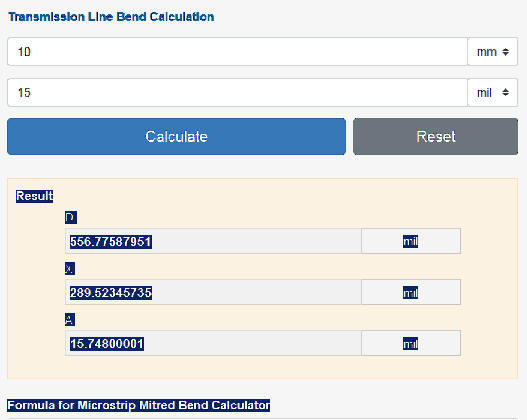|
z webu: Microwave Encyclopedia a https://www.everythingrf.com/rf-calculators/microstrip-mitred-bend-calculator Překlad: Zkosený
ohyb je
ohyb, který
je proveden
řezáním
zakřivených konců
přenosových
vedení pod
úhlem,
aby se
minimalizovalo
VSWR,
vložení a/nebo
zpětný útlum,
který se
jinak stává
hlavním
problémem v
ohybech
přenosového vedení. Jinak řečeno: trojůhelníkový spojovací útvar může být ještě "o chlup" tenčí, aby se zachovala impedance mikropásku. Můžete tak učinit i zkusmo.
Více tady: https://www.everythingrf.com/rf-calculators/microstrip-mitred-bend-calculator
Result
Formula for Microstrip Mitred Bend Calculator
Where, W = Width of the the line h = Height of the substrate D = The diagonal of a square miter A = Compensated length for optimal bend
What is a Mitered Bend?
A mitered bend is a bend that is made by cutting the curved ends of transmission lines at an angle to minimize the VSWR, insertion and/or return loss that otherwise becomes a major problem in the transmission line bends. When a transmission line is bent at 90˚ (approximately), small amounts of positive and negative charges build up on the bent surfaces of the transmission lines thereby causing capacitance to develop across the line. This results in a change in the impedance of the transmission line, which causes a mismatch at the load. This mismatch causes a fraction of the signal on the line to be reflected back towards its source which reduces the overall system performance. Therefore, it is necessary to remove this unwanted capacitance created when a transmission line is bent. Mitering is a process that is used to cut a portion of the line at a predetermined angle to minimize the capacitance at the bend. Mitering can be performed at any angle from 30˚ to 120˚. When the mitering is done at 45˚, the resulting line will look like what is shown in there figure above.. Here, the cut portion occurs at two corners of the line and the tilted section acts like a reflector that directs the incoming EM signal in a direction perpendicular to the incoming direction i.e. the signal will flow in the vertical direction along negative y-axis. However, other angles such as 22.5˚ can also be chosen to cut the line three times along the bend. So while a curved transmission line might look better, mitering is important as it reduces the losses in the transmission line bends.
|






